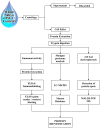Advances of Salivary Proteomics in Oral Squamous Cell Carcinoma (OSCC) Detection: An Update
- PMID: 28248250
- PMCID: PMC5260973
- DOI: 10.3390/proteomes4040041
Advances of Salivary Proteomics in Oral Squamous Cell Carcinoma (OSCC) Detection: An Update
Abstract
Oral cancer refers to malignancies that have higher morbidity and mortality rates due to the late stage diagnosis and no early detection of a reliable diagnostic marker, while oral squamous cell carcinoma (OSCC) is amongst the world's top ten most common cancers. Diagnosis of cancer requires highly sensitive and specific diagnostic tools which can support untraceable hidden sites of OSCC, yet to be unleashed, for which plenty of biomarkers are identified; the most recommended biomarker detection medium for OSCC includes biological fluids, such as blood and saliva. Saliva holds a promising future in the search for new clinical biomarkers that are easily accessible, less complex, accurate, and cost effective as well as being a non-invasive technique to follow, by analysing the malignant cells' molecular pathology obtained from saliva through proteomic, genomic and transcriptomic approaches. However, protein biomarkers provide an immense potential for developing novel marker-based assays for oral cancer, hence this current review offers an overall focus on the discovery of a panel of candidates as salivary protein biomarkers, as well as the proteomic tools used for their identification and their significance in early oral cancer detection.
Keywords: biomarkers; diagnosis; oral squamous cell carcinoma; saliva.
Conflict of interest statement
The authors declare no conflict of interest.
Figures
References
-
- Feller L., Lemmer J. Oral squamous cell carcinoma: Epidemiology, clinical presentation and treatment. J. Cancer Ther. 2012;3:263–268. doi: 10.4236/jct.2012.34037. - DOI
-
- Granato D.C., Zanetti M.R., Kawahara R., Yokoo S., Domingues R.R., Aragão A.Z., Agostini M., Carazzolle M.F., Vidal R.O., Flores I.L., et al. Integrated proteomics identified up-regulated focal adhesion-mediated proteins in human squamous cell carcinoma in an orthotopic murine model. PLoS ONE. 2014;9:e98208. doi: 10.1371/journal.pone.0098208. - DOI - PMC - PubMed
Publication types
LinkOut - more resources
Full Text Sources
Other Literature Sources



